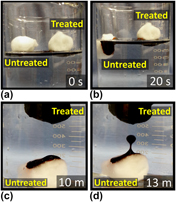Crossref Citations
This article has been cited by the following publications. This list is generated based on data provided by
Crossref.
Losego, Mark D.
and
Peng, Qing
2019.
Surface Modification of Polymers.
p.
135.
Gregory, Shawn A.
McGettigan, Connor P.
McGuinness, Emily K.
Rodin, David Misha
Yee, Shannon K.
and
Losego, Mark D.
2020.
Single-Cycle Atomic Layer Deposition on Bulk Wood Lumber for Managing Moisture Content, Mold Growth, and Thermal Conductivity.
Langmuir,
Vol. 36,
Issue. 7,
p.
1633.
Berman, Diana
and
Shevchenko, Elena
2020.
Design of functional composite and all-inorganic nanostructured materials via infiltration of polymer templates with inorganic precursors.
Journal of Materials Chemistry C,
Vol. 8,
Issue. 31,
p.
10604.
Li, Yi
Chen, Lihua
Wooding, Jamie P.
Zhang, Fengyi
Lively, Ryan P.
Ramprasad, Rampi
and
Losego, Mark D.
2020.
Controlling wettability, wet strength, and fluid transport selectivity of nanopaper with atomic layer deposited (ALD) sub-nanometer metal oxide coatings.
Nanoscale Advances,
Vol. 2,
Issue. 1,
p.
356.
Wooding, Jamie P.
Li, Yi
Kalaitzidou, Kyriaki
and
Losego, Mark D.
2020.
Engineering the interfacial chemistry and mechanical properties of cellulose-reinforced epoxy composites using atomic layer deposition (ALD).
Cellulose,
Vol. 27,
Issue. 11,
p.
6275.
Lu, Jianwei
Li, Yi
Song, Wei
Losego, Mark D.
Monikandan, Rebhadevi
Jacob, Karl I.
and
Xiao, Ru
2020.
Atomic Layer Deposition onto Thermoplastic Polymeric Nanofibrous Aerogel Templates for Tailored Surface Properties.
ACS Nano,
Vol. 14,
Issue. 7,
p.
7999.
Li, Yun
Xiong, Yingfei
Yang, Huizhi
Cao, Kun
and
Chen, Rong
2020.
Thin film encapsulation for the organic light-emitting diodes display via atomic layer deposition.
Journal of Materials Research,
Vol. 35,
Issue. 7,
p.
681.
Ashurbekova, Ka
Ashurbekova, Kr
Botta, G
Yurkevich, O
and
Knez, M
2020.
Vapor phase processing: a novel approach for fabricating functional hybrid materials.
Nanotechnology,
Vol. 31,
Issue. 34,
p.
342001.
Meng, Xiangbo
2020.
Atomic layer deposition of solid-state electrolytes for next-generation lithium-ion batteries and beyond: Opportunities and challenges.
Energy Storage Materials,
Vol. 30,
Issue. ,
p.
296.
Zara, Damiano La
Zhang, Fuweng
Sun, Feilong
Bailey, Maximilian R.
Quayle, Michael J.
Petersson, Gunilla
Folestad, Staffan
and
van Ommen, J. Ruud
2021.
Drug powders with tunable wettability by atomic and molecular layer deposition: From highly hydrophilic to superhydrophobic.
Applied Materials Today,
Vol. 22,
Issue. ,
p.
100945.
Ren, Yi
McGuinness, Emily K.
Huang, Chaofan
Joseph, V. Roshan
Lively, Ryan P.
and
Losego, Mark D.
2021.
Reaction–Diffusion Transport Model to Predict Precursor Uptake and Spatial Distribution in Vapor-Phase Infiltration Processes.
Chemistry of Materials,
Vol. 33,
Issue. 13,
p.
5210.
Li, Yi
and
Losego, Mark D.
2021.
Impact of trimethylaluminum exposure time on the mechanical properties of single-cycle atomic layer deposition modified cellulosic nanopaper.
Journal of Vacuum Science & Technology A: Vacuum, Surfaces, and Films,
Vol. 39,
Issue. 5,
Li, Yi
Wooding, Jamie P.
McGuinness, Emily K.
Sun, Yici
and
Losego, Mark D.
2021.
Thermally Stimulated Wettability Transformations on One-Cycle Atomic Layer Deposition-Coated Cellulosic Paper: Applications for Droplet Manipulation and Heat Patterned Paper Fluidics.
ACS Applied Materials & Interfaces,
Vol. 13,
Issue. 11,
p.
13802.
Yang, Xiaobin
Martinson, Alex B.F.
Elam, Jeffrey W.
Shao, Lu
and
Darling, Seth B.
2021.
Water treatment based on atomically engineered materials: Atomic layer deposition and beyond.
Matter,
Vol. 4,
Issue. 11,
p.
3515.
Zhang, Ying-Peng
Yang, Xiao
Zhao, Yu-Chen
Yang, Yun-Shang
and
Zhang, Hong-Rui
2022.
Novel ferrocene chalcone organic gels for oil spill treatment and recovery.
Journal of Hazardous Materials Advances,
Vol. 8,
Issue. ,
p.
100194.
Pyronneau, Kira
McGuinness, Emily K.
Gonzalez, Alan J.
Jean, Benjamin C.
Manno, Haley V.
McClelland, Nicole R.
and
Losego, Mark D.
2022.
Wash Fastness of Hybrid AlOx-PET Fabrics Created via Vapor-Phase Infiltration.
ACS Applied Polymer Materials,
Vol. 4,
Issue. 5,
p.
3304.
Bhamare, Vijaykumar S.
and
Kulkarni, Raviraj M.
2023.
Advanced Flexible Ceramics.
p.
215.
Gurbandurdyyev, Guvanch
Mistry, Kissan
Delumeau, Louis‐Vincent
Loke, Jhi Yong
Teoh, Chee Hau
Cheon, James
Ye, Fan
Tam, Kam Chiu
and
Musselman, Kevin P.
2023.
Robust, Conformal ZnO Coatings on Fabrics via Atmospheric‐Pressure Spatial Atomic Layer Deposition with In‐Situ Thickness Control**.
ChemNanoMat,
Vol. 9,
Issue. 2,
Lu, Jianwei
Qiao, Yufei
Jiang, Yangang
Ali, Amjad
and
Guo, Li
2024.
Fabrication of highly carboxylated nanofibrous aerogels under mild conditions and their protein adsorption performance.
International Journal of Biological Macromolecules,
Vol. 281,
Issue. ,
p.
136636.
Zhang, Li
Li, Yi
Sun, Leila
Balogun, Shuaib A.
and
Losego, Mark D.
2025.
Enzymatic degradation of cellulosic fabrics modified with atomic layer deposited aluminum oxide thin films.
Journal of Vacuum Science & Technology B,
Vol. 43,
Issue. 2,



